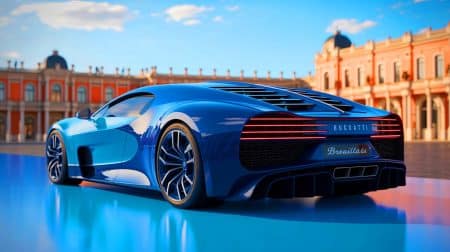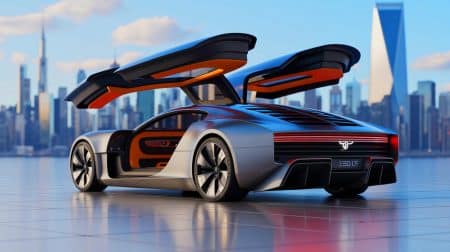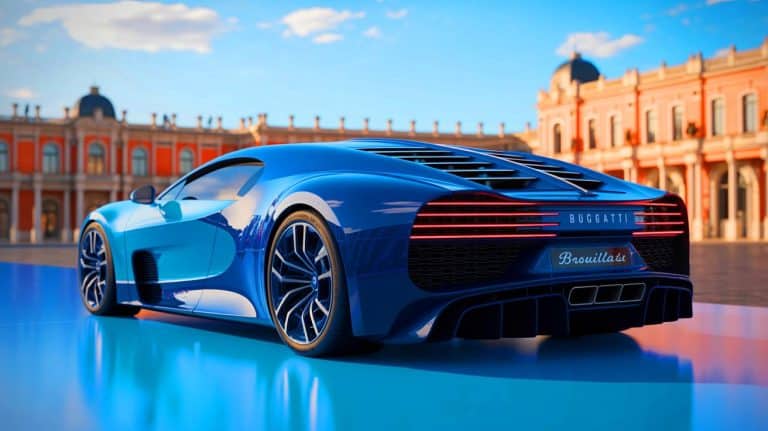| IN A NUTSHELL |
|
The Bugatti Brouillard, a one-of-a-kind supercar, has made its way to Europe following its debut in California, marking a significant moment in automotive history. This exclusive vehicle, celebrated during the prestigious Monterey Car Week, is the last of its kind, powered by the iconic W16 engine. As it embarks on its European tour, the Brouillard stands as a testament to Bugatti’s engineering prowess and the legacy of the W16 engine. Car enthusiasts eagerly await its appearances across the continent, aware that this may be the last time such an engineering marvel is showcased in public.
The Legacy of the Bugatti Brouillard
The Bugatti Brouillard holds a special place in the storied history of Bugatti, serving as both a farewell to the Chiron model and a celebration of the W16 engine. This engine, an 8.0-liter powerhouse capable of producing 1,577 horsepower, has been a cornerstone of Bugatti’s recent models. Though the Brouillard’s engine power pales in comparison to the newly developed hybrid V16, it remains significant as it represents the end of an era for the famed W16.
The Brouillard’s unveiling at the Wheels Marienwaerdt event in the Netherlands kickstarted its European journey. This tour provides a unique opportunity for automotive aficionados to witness a piece of history. However, the vehicle’s future is somewhat predictable—it will likely return to its owner and remain in storage until it eventually surfaces at an auction. The Brouillard, therefore, is both a historical artifact and a symbol of a bygone era of pure combustion engines in Bugatti’s lineup.
The End of an Era: The Last W16 Bugatti
The Brouillard marks the end of the W16 era for Bugatti, an era that began with the Veyron in 2005. Over the years, this engine became synonymous with Bugatti's identity, powering not only the Veyron but also the Chiron, the Divo, and several other high-profile models. Bugatti's commitment to the W16 has persisted for two decades, making its retirement a monumental moment for the marque.
As Bugatti transitions to the more powerful V16, which integrates hybrid technology, some collectors remain skeptical. The electrification of Bugatti's engines marks a shift towards modernity and environmental responsibility. However, purists who appreciate the raw, unadulterated power of the W16 may find the new direction less appealing. The Brouillard, therefore, stands as a bridge between the past and the future of high-performance automotive engineering.
Supercar road trips: The best routes for driving enthusiasts
Bugatti's Evolution and Future Prospects
As Bugatti embarks on a new chapter with its hybrid V16 engine, the automotive world watches closely. This transition represents not only a technical evolution but also a shift in philosophy for a brand known for its uncompromising dedication to power and performance. The shift towards hybrid technology aligns with broader industry trends towards sustainability and efficiency.
Bugatti's future models are expected to combine traditional luxury with cutting-edge technology. The challenge lies in balancing these elements while maintaining the brand's core identity. The introduction of hybrid technology could open up new possibilities for innovation, potentially attracting a new generation of Bugatti enthusiasts. However, the brand must also navigate the expectations of loyalists who cherish the legacy of the W16.
The Cultural Impact of Bugatti's Supercars
Bugatti's supercars have always been more than just vehicles; they are cultural icons representing the pinnacle of automotive achievement. The Brouillard, as the last W16 model, holds significant cultural value, symbolizing both the end of an era and the beginning of a new one. Events showcasing such vehicles often become cultural milestones, drawing attention from car enthusiasts and the general public alike.
As the Brouillard tours Europe, it serves as a reminder of the artistry and engineering excellence that Bugatti represents. The car's journey not only showcases its mechanical prowess but also its ability to inspire awe and admiration. The cultural impact of Bugatti's supercars extends beyond the automotive world, influencing design, technology, and even pop culture. The Brouillard's legacy will likely endure, sparking conversations about innovation, luxury, and the future of the automotive industry.
As the Bugatti Brouillard continues its tour across Europe, it invites us to reflect on the legacy of the W16 engine and the evolution of automotive engineering. This transition period raises questions about the future of high-performance vehicles and the role of hybrid technology in preserving the essence of brands like Bugatti. How will the automotive industry balance tradition with innovation in the years to come?
Did you like it? 4.4/5 (29)






Is this really the end of the W16 era for Bugatti? 😢
Is the Bugatti Brouillard available for public viewing during its European tour? 🚗
Could the Brouillard be considered a collector’s treasure in the future?
End of an era or beginning of a new one? Hybrid technology seems like a step forward but will it have the same charm? 🤔
Why is everyone panicking about electric cars? It’s the future!
How exactly does the new V16 engine compare to the W16 in terms of performance?
I will miss the roar of the W16 engine. Electric cars just don’t have the same soul.
Such a shame, will miss the roar of the W16 engine. 😢
What an incredible journey for the Brouillard. Wish I could see it in person! 🚗💨
Does the shift to hybrid technology mean Bugatti is going green? 🌱
Hybrid V16? Sounds like Bugatti is taking a step forward!
Bugatti should’ve gone electric sooner. The world is changing, and they need to keep up!
I’m skeptical about the hybrid transition. Will it really maintain Bugatti’s identity?